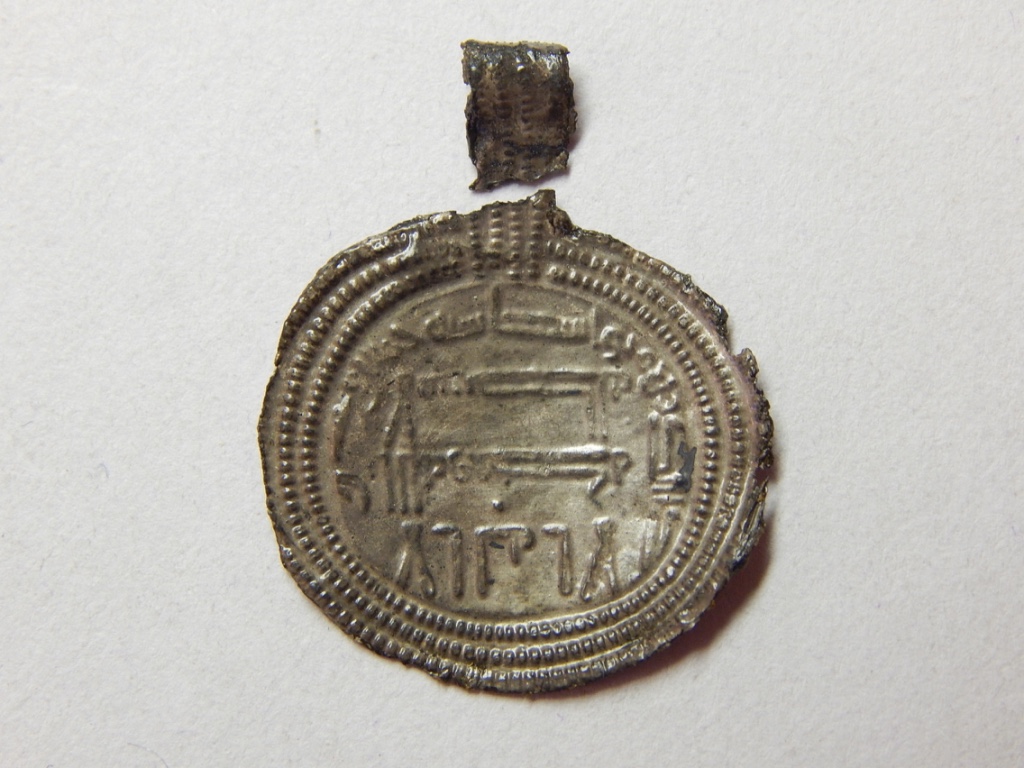Silver dirhams were not exclusively brought in by way of trade with the Middle East and Central Asia but were produced within the Viking world as well. These were far from exact replicas of the originals but were made with silver and contained pseudo-Arabic writing. One example would be a series of fourteen faux dirhams found in the grave of a woman buried in a boat grave in Tuna, Badelunda in modern Sweden.1 These seem to have been made by the Vikings themselves although specifically in imitation of the silver dirhams that were simultaneously coming into the Viking world through trade with the Middle East and Central Asia. We can infer this based on the pseudo-Arabic script on the coins which sometimes contains writing that is illegible or gibberish but also, occasionally, actual Arabic words, such as the word bakh, which in early Islamic coins referred to the coin being “first-class.”

Pendant from Grave 75 at Tuna i Badelunda, SE.
One-sided dirham impression in silver.
(source: M Delvaux)
There is a wide variety in the quality of faux Arabic script on these pseudo-Arabic coins. For one of the coins found at Tuna, the script is convincing enough that it looks like Arabic to the untrained eye. Indeed, despite the fact that these coins were usually struck by people with no knowledge of Arabic script, they often did have certain words correct, such as the aforementioned bakh. These coins do exhibit some other differences beyond their script. The Samanid dirhams, such as those found on the Isle of Skye, usually had writing all around the face of the coin. The Tuna coin, instead, has a very substantial decorative rim pattern around the coin. This could perhaps be due to curved Arabic script being more difficult to replicate than the more straight-lined writing positioned in the center.
In his article on Islamic coins at Kaupang in modern Norway, Kilger seeks to interpret and contextualize the Islamic coins found there which are unique in that, compared to the rest of Scandinavia where Samanid coins are predominant, Abbasid coins are far more common by a large margin in Kaupang.2 To explain this, Kilger analyzes Viking deposits beyond Scandinavia in regions such as the Caucasus, Russia, and the Baltic Coast to determine shifts in the intra-Viking trade in Islamic coins over time. He suggests that Kaupang was once an early Viking center when Abbasid coins were in circulation and specialized in the handling of silver and reshaping it, forming it into weights or ingots. However, it eventually declined in prominence during the 10th century CE, by which time Samanid silver had come to dominate.

Counterfeit dirham from hoard at Pusi, Estonia.
Two pieces of pressed silver, 1.24 g.
(source: Leimus et al., pdf)
Through Kilger’s article, we get a better understanding that the Viking Age was not a monolith of groups but a very diverse, and sometimes disparate, set of people who engaged in their own interactions. Although culturally interconnected as well as through trade in their shared use of emporia like Hedeby and Ribe, this did not cause a uniform social or economic culture to be formed across Scandinavia and the greater Viking world. Furthermore, these interactions changed over time as we see through the rise and fall of Kaupang entirely within the Viking Age.
We also get an idea that the trade in Islamic silver was as much a trade between Vikings as it was between Vikings and the Islamic world. The widespread distribution of Islamic silver across regions such as the Caucasus, Eastern Europe, and Scandinavia suggests an economic life for Islamic silver well after its production and entry into the Viking world.

Khazar imitation dirham inscribed “Moses is the Messenger of God.”
Specimen recovered from hoard at Spillings, SE.
Minted Khazaria, ca. 800.
(source: Wikimedia)
How does this relate to the dirham copies that we say in places like Tuna? I would argue that’s in the way that the Islamic silver had itself become a part of Viking culture. We know that the dirhams imported from the Islamic world were traded in their original form as well as melted down into ingots or manufactured into weights and jewelry. However, we know that some of this silver must’ve been reshaped into faux dirhams, suggesting that Islamic coins had a cultural value and significance in the Viking world beyond simply as coins or sources of silver. The faux dirham at Tuna, for example, was found as part of a woman’s set of beads alongside fourteen other replicas. As compared to the ring with “For/to God” inscribed on it, which I remain unsure as to what sort of cultural or significance it would’ve held beyond its aesthetic value, we can be certain that Islamic coins had become a desirable product with a reputation in their own right within the Viking world. In such a way, both Islamic coins and their replicas became indigenized as Viking goods, with the latter possibly emerging as a cheaper or lower-quality version of the former.
1 Erik Nylén and Bengt Schönbäck, Tuna i Badelunda. Guld, kvinnor, båtar (Uppsala: Almqvist and Wiksell, 1994): I:58–63.
2 Christoph Kilger, “Kaupang from Afar: Aspects of the Interpretation of Dirham Finds in Northern and Eastern Europe between the Late 8th and Early 10th Centuries,” in Means of Exchange: Dealing with Silver in the Viking Age, ed. Dagfinn Skre (Aarhus: Aarhus University Press, 2008), 199–252.
« Previous | Home | Next »